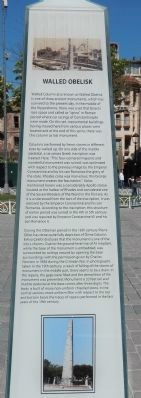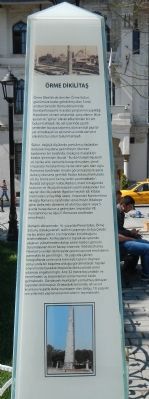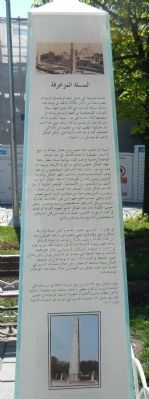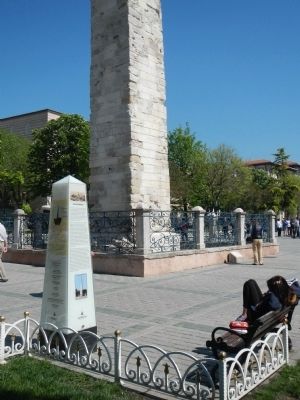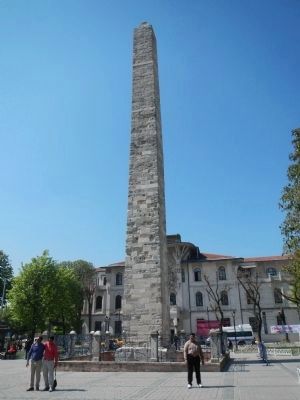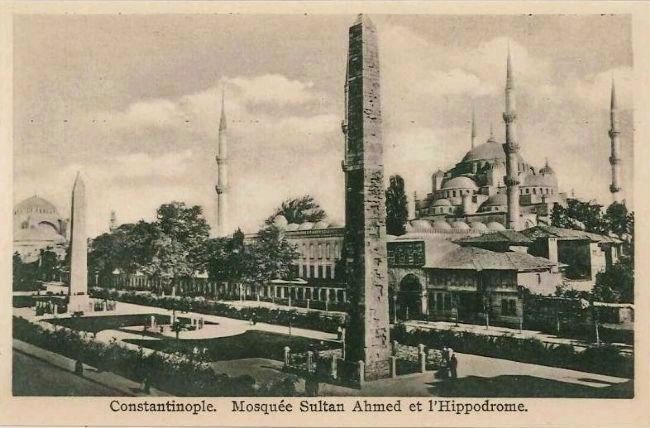Binbirdirek in İstanbul in Fatih, Turkey — West Asia or Southeast Europe
Walled Obelisk
Örme Dikilitaş
Walled Column also known as Walled Obelisk is one of three ancient monuments, which has survived to the present day. In the middle of the Hippodrome, there was a set that bisects race space and called as "spina" in Roman period where car racings of Constantinople were made. On this set, monumental buildings having moved here from various places were located and at the end of this spina, there was this column as last monument.
Columns are formed by hewn stones in different sizes by walled up. On one side of the marble pedestal, a six verses Greek inscription was treated. Here, "This four-cornered majestic and wonderful monument was ruined, was optimized with respect to the previous image by the Emperor Constantine and by his son Romanos the glory of the state. Rhodes colos was marvelous; this bronze monument creates the fascination " Kolos mentioned herein was a considerably Apollo statue located at the harbor of Rhodes and considered one of the Seven Wonders of the World in the first era. As it is understood from the text of the inscription, it was restored by the Emperor Constantine and his son Romanos. According to the inscription; this structure of earlier period was ruined in the 4th or 5th century and was repaired by Emperor Constantine VII and his son Romanos II.
During the Ottoman period in the l6th century Pierre Gilles has done quite fully depiction of Örme Column. Evliya Celebi discloses that the monument is one of the city's charms. Due to the ground-level rise of At meydanr, while the base of the monument is embedded, was surrounded by railings around by opening the base surroundings with the permission given by Charles Newton in 1856 during the Crimean War. In photographs taken in the 19th century, a result of falling of the stones of monument in the middle part, there seems to be a drain. In the repairs, the gaps were filled and the demolition of the monument was prevented. Monument is 32 feet tall and marble pedestal at the base comes after three digits. The body is built of many non-uniform chiselled stone. in the central section, more uniform filler with respect to the top and bottom bears the traces of repairs performed in the last years of the l9th century.
Turkish:
Örme Obelisk de denilen Örme Sütun, günümüze kadar gelebilmiş olan 3 eski anıttan birisidir. Roma döneminde Konstantinopolis'in araba yarışlarının yapıldığı Hıpodrom'un tam ortasında, yarış alanını ikiye ayıran ve "spina" olarak adlandırılan bir set bulunmaktaydı. Bu set üzerinde çeşitli yerlerden buraya taşınmış olan anıtsal yapılar yer almaktaydı ve spinanın ucunda son anıt olarakta bu sütun bulunmaktaydı.
Sütun değişik ölçülerde yontulmuş taşlardan örülerek meydana getirilmiştir. Mermer kaidesinin bır tarafında, Grekçe 6 mısralık bir kitabe işlenmiştir. Burda "Bu dört köseli heybetli ve harika anıt, zamanla harap olmuşken, şimdi İmparator Konstantinos ile devletin şanı olan oğlu Romanos tarafından önceki görüntüsüne nispetle daha iyi duruma getirildi; Rodos kolosu harikulade idi, bu bronz anıt ise hayranlık yaratmaktadır". Burada adı geçen kolos, Rodos Limanı'nın ağzında bulunan ve ilkçağ dünyasının yedi harikasından biri sayılan dev ölçüde bir Apolion heykeli idi. Kitabe metninden anlaşıldığı üzere, İmparator Konstantinos ile oğlu Romanos tarafından onarılmıştır. Kitabeye göre; daha eski döneme ait olan bu yapı 4. veya 5. asırda harap durun a gelmişken, İmparator VII. Konstantinos ve oğlu II. Romanos tarafından onarılmıştır.
Osmanlı döneminde, 16. yüzyılda Pierre Gilles, Örme Sütunu oldukça etraflı tasfirini yapmıştır, Evliya Çelebi ise bu anıtın şehrin tılsımlarından biri olduğunu bildirmektedir. At Meydanının toprak seviyesinde yaşanan yükselmeden dolayı anıtın kaidesi gömülü durumdayken Kırım Savaşı sırasında 1856'da Charles Newton'a verilen izinle kaide çevresi açılarak etrafı demir parmaklık ile çevrilmiştir. 19. yüzyılda çekilen fotoğraflarda anıtın orta kısmında taşların düşmesi sonucunda bir boşalma olduğu görülmektedir. Yapılan onarımlarda buradaki boşluklar doldurularak anıtın yıkılması engellenmiştir. Anıt 32 metre boyundadır ve temelindeki üç basamaktan sonra mermer kaide gelmektedir. Gövde pek muntazam yontulmuş olmayan taşlardan örülmüştür. Ortalardaki bölümde, alt ve üst kısımlara nispetle daha muntazam olan dolgu, 19. yüzyılın son yıllarında yapılan onarımın izlerini taşımaktadır.
Arabic: To read the Arabic text, click on the Arabic image to enlarge it.
Erected by Istanbul Büyükşehir Belediyesi (Istanbul Metropolitan Municipality).
Topics. This historical marker is listed in this topic list: Landmarks. A significant historical year for this entry is 1856.
Location. 41° 0.34′ N, 28° 58.506′ E. Marker is in İstanbul, in Fatih. It is in Binbirdirek. Marker is on Atmeydanı Caddesi close to Terzihane Sokak. Touch for map. Marker is at or near this postal address: Atmeydanı Cd 53, İstanbul 34122, Turkey. Touch for directions.
Other nearby markers. At least 8 other markers are within walking distance of this marker. Obelisk of Theodosius (within shouting distance of this marker); Serpent Column (within shouting distance of this marker); German Fountain (about 210 meters away, measured in a direct line); St. Euphemia's Martyrion (about 210 meters away); Mausoleum of Sultan Ahmed I (approx. 0.2 kilometers away); Cistern of Philoxenos (approx. 0.3 kilometers away); Firuz Aga Mosque (approx. 0.3 kilometers away); Kapi Agasi Mahmud Aga Mosque (approx. 0.3 kilometers away). Touch for a list and map of all markers in İstanbul.
More about this marker. This Obelisk is located at the southwest end of the Hippodrome.
Credits. This page was last revised on February 13, 2023. It was originally submitted on June 25, 2015, by Barry Swackhamer of Brentwood, California. This page has been viewed 417 times since then and 20 times this year. Photos: 1, 2, 3, 4, 5. submitted on June 25, 2015, by Barry Swackhamer of Brentwood, California. 6. submitted on July 16, 2015. • Andrew Ruppenstein was the editor who published this page.
